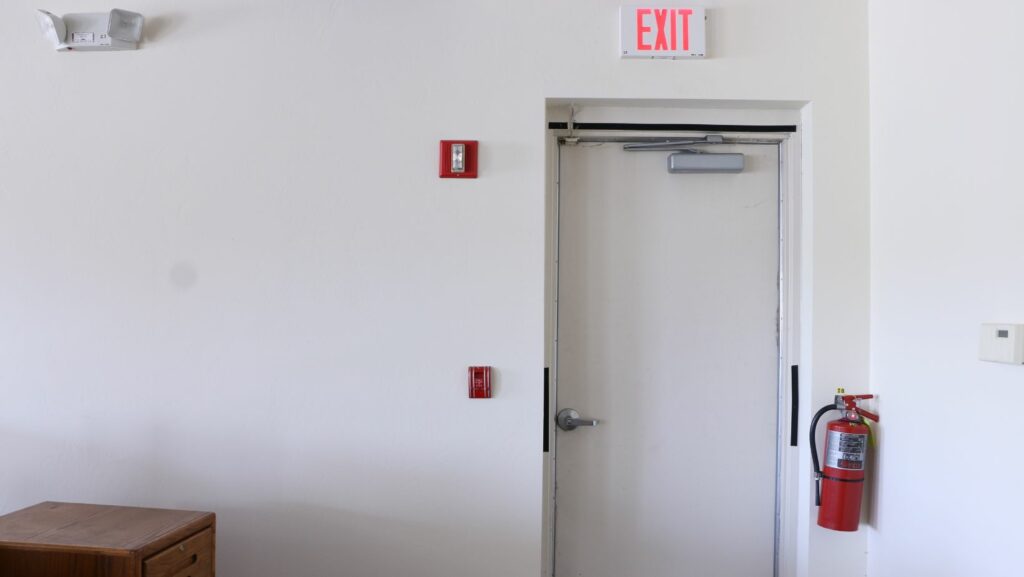Ensuring HMO fire door compliance is essential for protecting tenants and fulfilling legal requirements. Fire doors play a critical role in preventing the spread of fire and smoke, providing a safe evacuation route for occupants. This guide provides detailed steps to help landlords and property managers achieve compliance with HMO fire door regulations.
Understanding the Legal Requirements for HMO Fire Doors
Fire doors in Houses in Multiple Occupations (HMOs) must comply with legal standards outlined by local authorities and building regulations. These regulations typically require that fire doors must have a 30-minute fire resistance rating, known as FD30. Fire doors should be fitted with intumescent strips and smoke seals to prevent the spread of smoke and fire. Self-closing mechanisms are also mandatory to ensure the door closes automatically after use. Compliance with these requirements is not only a legal obligation but also a critical measure for ensuring the safety of occupants. For specific compliance details and installation in London, consider professional services for HMO Fire Doors London to ensure full adherence to regulations.
Key Features of Compliant Fire Doors
Fire doors used in HMOs must be constructed from fire-resistant materials. The key feature of a compliant fire door is its ability to withstand fire and prevent the spread of flames and smoke. Fire doors should have a solid core that is capable of withstanding high temperatures and maintaining its structural integrity during a fire. Intumescent strips are designed to expand when exposed to heat, sealing gaps around the door to prevent the infiltration of smoke and fire. Another essential feature is the self-closing mechanism, which ensures the door automatically closes after being opened, thus minimizing the risk of fire spreading.
Identifying Non-Compliant Fire Doors
It is essential to regularly inspect fire doors to identify non-compliant ones. Some common signs that a fire door is not compliant include the absence of an FD30 rating or other fire resistance certification.

Additionally, missing or damaged seals and intumescent strips, as well as the lack of a functioning self-closing mechanism, indicate non-compliance. Gaps around the edges of the door that are too wide can also compromise its fire resistance. It is crucial to conduct regular inspections to ensure the doors continue to meet fire safety standards and to address any issues promptly.
Professional Installation of Fire Doors
Fire doors should only be installed by certified professionals to ensure full compliance with safety standards. A professional installation ensures that the fire doors are correctly fitted into the frame and are sealed with the proper intumescent strips and smoke seals. Additionally, self-closing devices and hinges must be installed according to fire safety regulations. Qualified installers are trained to ensure that fire doors are fitted correctly to maximize their effectiveness in case of a fire. Improper installation can undermine the effectiveness of the fire doors, so it is essential to hire professionals with experience in installing fire doors for HMOs.
The Importance of Regular Inspections and Maintenance
Regular inspections are essential to ensure fire doors remain effective over time. A fire door that was compliant when first installed may develop issues over time that could compromise its functionality. Inspections should be conducted at least once every six months, or more frequently in high-traffic areas. The inspection should include checking the door’s alignment, ensuring it closes properly, and assessing the condition of the intumescent strips and smoke seals. The self-closing mechanism should be tested to ensure it functions correctly. Any defects or damage should be addressed immediately to ensure the door continues to provide the required level of protection.
Common Defects and How to Resolve Them
Fire doors may experience defects over time due to wear and tear, environmental factors, or improper use. Common defects include warped or damaged doors, worn-out seals, and malfunctioning self-closing mechanisms. It is important to identify these issues promptly and carry out necessary repairs. For example, if the door is warped or damaged, it may need to be replaced. Seals and intumescent strips should be replaced if they are worn out or damaged.

Malfunctioning self-closing mechanisms must be repaired or replaced to ensure the door functions properly during an emergency. Repairs should always be carried out by professionals to maintain compliance with fire safety regulations.
Ensuring Full Compliance with Fire Door Regulations
Compliance with fire door regulations is an ongoing responsibility for landlords and property managers. After the initial installation, it is important to maintain regular inspections to ensure the fire doors continue to meet the required standards. This includes checking for any defects, ensuring all components are functioning correctly, and replacing any damaged parts. It is also essential to keep accurate records of inspections and repairs to demonstrate compliance during audits or inspections by local authorities. By keeping detailed records and addressing any issues promptly, landlords and property managers can ensure they meet legal requirements and provide a safe environment for their tenants.
Conclusion
Ensuring HMO fire door compliance is a critical responsibility for property managers and landlords. Fire doors must meet specific requirements, including fire resistance ratings, proper seals, and self-closing mechanisms. Regular inspections, professional installation, and prompt maintenance are essential steps in achieving compliance.

